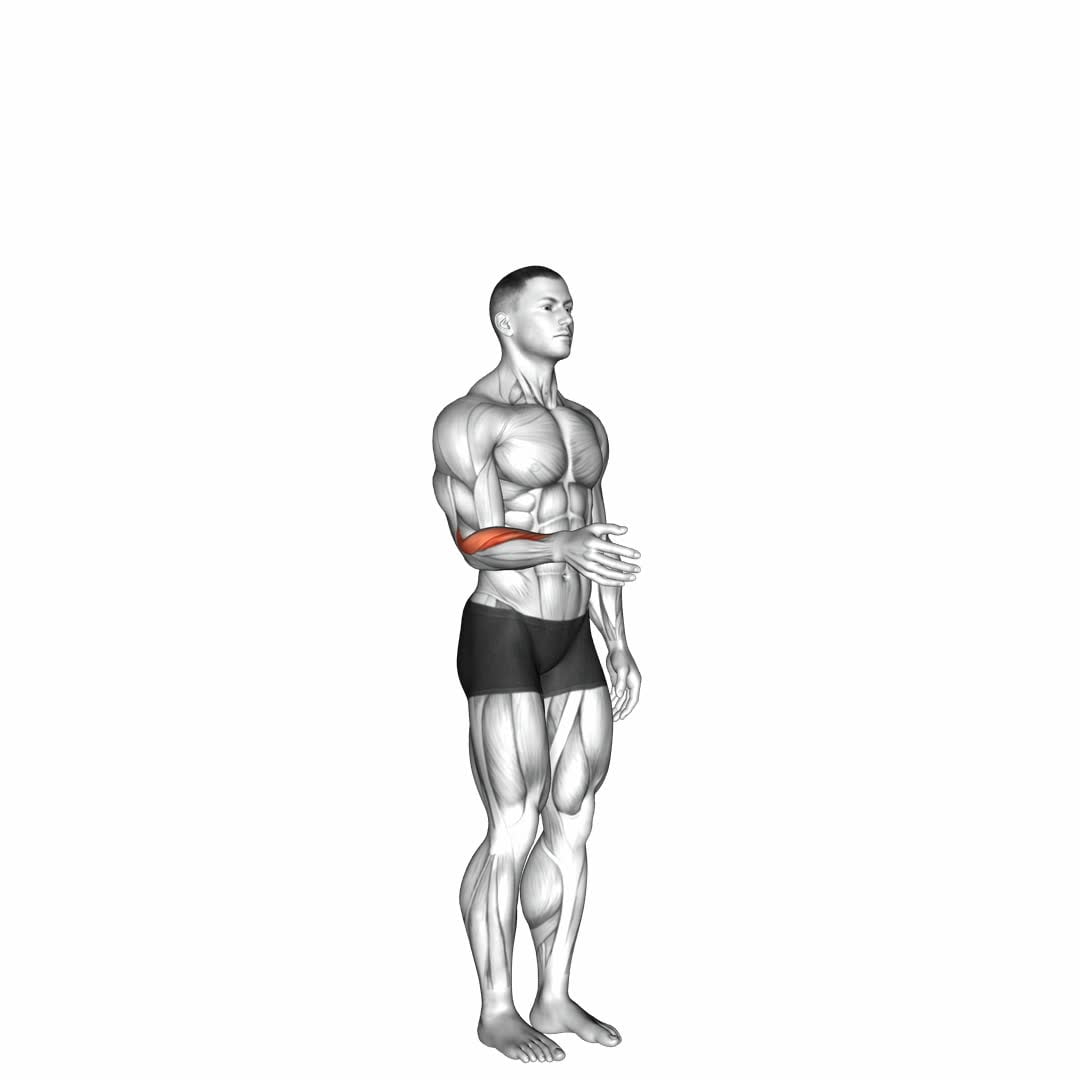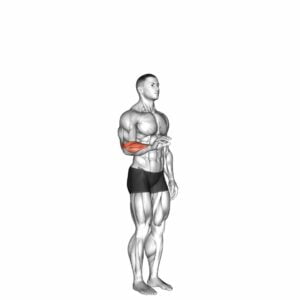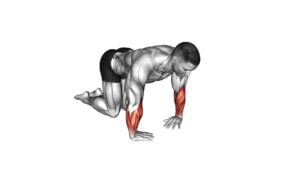Wrist – Adduction – Video Exercise Guide & Tips

Looking to strengthen your wrists? In this video exercise guide, we'll show you how to perform wrist adduction exercises effectively. By following proper form and utilizing the right equipment, you can maximize the benefits of these exercises.
Watch This Exercise Video
We'll also provide variations to keep your routine interesting and offer tips to help you get the most out of your wrist adduction workout.
Remember to prioritize safety and consult with a professional if needed.
Let's get started!
Key Takeaways
- Wrist adduction exercises are effective in preventing wrist injuries.
- These exercises improve grip strength and reduce the risk of wrist sprains and strains.
- Proper form and technique are important in maximizing the benefits and avoiding strain or injury.
- Equipment and modifications can be used to provide stability and support for the wrists during these exercises.
Benefits of Wrist Adduction Exercises
You will experience several benefits from performing wrist adduction exercises. These exercises are highly effective in preventing wrist injuries and improving grip strength. By regularly incorporating wrist adduction exercises into your workout routine, you can significantly reduce the risk of common wrist injuries such as sprains and strains.
One of the main benefits of wrist adduction exercises is the improvement in grip strength. These exercises specifically target the muscles in your wrists and forearms that are responsible for gripping and holding objects. As a result, you'll notice a significant increase in your ability to grip and hold onto objects with greater strength and stability.
Additionally, wrist adduction exercises help to strengthen the muscles and tendons in your wrists, which can help prevent injuries. Stronger wrists are less prone to strains and sprains, especially when performing activities that involve repetitive or forceful wrist movements, such as lifting heavy objects or participating in sports.
Proper Form for Wrist Adduction Exercises
To ensure proper form for wrist adduction exercises, it's important to maintain a neutral wrist position throughout the movement. This means keeping your wrist in a straight line with your forearm, without any excessive bending or twisting. By maintaining a neutral wrist position, you can target the muscles responsible for wrist adduction more effectively and reduce the risk of injury.
One of the benefits of wrist adduction exercises is that they help to strengthen the muscles in the inner part of your forearm, known as the flexor muscles. This can improve your grip strength and make daily tasks that involve gripping and lifting objects easier. Additionally, wrist adduction exercises can help to improve your overall wrist stability and coordination.
When performing wrist adduction exercises, it's important to avoid common mistakes that can compromise your form and effectiveness. One common mistake is allowing your wrist to drop or collapse during the movement. This can shift the focus away from the target muscles and place unnecessary stress on your wrist joint.
Another mistake is using too much weight or resistance, which can lead to improper form and increase the risk of injury. It's important to start with lighter weights or resistance bands and gradually increase as your strength improves.
Equipment Needed for Wrist Adduction Exercises
To perform wrist adduction exercises effectively and safely, it's important to have the appropriate equipment. Here are five items you'll need for wrist adduction exercises:
- Dumbbells: Choose dumbbells that are comfortable for your grip and provide enough resistance for your desired level of intensity. Start with lighter weights and gradually increase as you build strength.
- Wrist roller: This device consists of a rod with a weight attached to a rope or chain. It's specifically designed to target the muscles involved in wrist adduction. Simply roll the weight up and down using your wrist muscles.
- Resistance bands: These elastic bands come in different levels of resistance and are great for adding variety to your wrist adduction exercises. They can be used to provide resistance in different directions and angles.
- Wrist exercise ball: This small, handheld ball is designed to improve grip strength and wrist stability. It can be squeezed and rolled in various directions to target the muscles involved in wrist adduction.
- Wrist adduction machine: This machine provides a controlled and stable environment for performing wrist adduction exercises. It allows you to adjust the resistance and range of motion according to your needs and fitness level.
Having the right equipment is essential for performing wrist adduction exercises effectively and maximizing your results. Invest in these items to ensure a safe and efficient workout.
Variations of Wrist Adduction Exercises
For variations of wrist adduction exercises, try incorporating different equipment and techniques. By introducing new elements into your workout routine, you can reap even more benefits from these exercises.
Wrist adduction exercises help strengthen the muscles in your forearm, improving grip strength and wrist stability. They also promote better coordination and flexibility in the wrist joint, which can be beneficial for athletes and individuals who engage in activities that require precise hand movements.
To progress and vary your wrist adduction exercises, you can start by using resistance bands or weights to increase the intensity of the exercise. Begin with lighter resistance and gradually increase as you build strength and endurance.
Another variation is to perform wrist adduction exercises on an unstable surface, such as a balance board or stability ball. This challenges your muscles even more as they work to stabilize your wrist in addition to performing the movement.
Incorporating different techniques can also enhance your wrist adduction exercises. For example, you can perform the exercises with a pronated grip (palms facing down) or supinated grip (palms facing up) to target different muscles in the forearm. You can also try performing the exercises with a slow and controlled tempo, focusing on the mind-muscle connection and proper form.
Tips for Getting the Most Out of Wrist Adduction Exercises
To maximize the effectiveness of your wrist adduction exercises, it's crucial to maintain proper form throughout the movements. Avoid common mistakes such as using excessive weight or not engaging the targeted muscles fully.
Additionally, to continue making progress, consider incorporating progression and variation into your workout routine.
Proper Form Importance
Get the most out of your wrist adduction exercises by focusing on proper form. Proper form is essential for maximizing the benefits of wrist adduction exercises. By maintaining the correct form, you can ensure that you're targeting the right muscles and avoiding unnecessary strain or injury.
Here are five tips to help you maintain proper form while performing wrist adduction exercises:
- Start with a light weight: Begin with a weight that allows you to perform the exercise with proper technique and control.
- Keep your wrist straight: Avoid any excessive bending or twisting of the wrist during the exercise.
- Engage your forearm muscles: Focus on contracting the muscles in your forearm throughout the movement.
- Control the movement: Perform the exercise in a slow and controlled manner, avoiding any jerking or sudden movements.
- Use a full range of motion: Make sure to move your wrist through its full range of motion, from a neutral position to adduction.
Common Mistakes to Avoid
Avoid these three common mistakes to get the most out of your wrist adduction exercises.
First, make sure you're using proper technique. Many people tend to rush through the exercise, sacrificing form for speed. Instead, focus on slow and controlled movements to effectively target the muscles.
Second, avoid excessive wrist flexion. This occurs when you bend your wrist too much during the exercise, placing unnecessary strain on the joint. Keep your wrist in a neutral position to avoid injury and maximize the benefits of the exercise.
Finally, don't neglect the importance of warming up and stretching before and after your workout. This helps to prevent injuries and prepares your muscles for the exercise.
Progression and Variation
Maximize the effectiveness of your wrist adduction exercises by incorporating progression and variation techniques. To take your workouts to the next level, try these tips:
- Increase the resistance: Gradually increase the weight or resistance used during your exercises to challenge your wrist adduction muscles.
- Modify the angle: Vary the angle at which you perform the exercise to target different muscles. You can try performing wrist adduction with your palm facing up or down.
- Change the grip: Experiment with different grips, such as overhand or underhand, to engage different muscle groups in your wrists and forearms.
- Integrate instability: Incorporate unstable surfaces, like a balance board or wobble cushion, to engage your core and improve wrist stability.
- Try advanced variations: Once you have mastered the basic wrist adduction exercises, you can progress to more advanced variations, such as performing the exercise with one hand or using a resistance band.
Precautions and Safety Measures for Wrist Adduction Exercises
Before you begin wrist adduction exercises, it's important to understand the proper form to avoid injuries. Maintaining proper form ensures that you're targeting the correct muscles and minimizing strain on your wrists.
Additionally, using the right equipment and making necessary modifications can help prevent injuries and provide a safer workout experience.
Proper Form Importance
To ensure proper form and reduce the risk of injury during wrist adduction exercises, it's essential to focus on your hand placement. Here are some precautions and safety measures to keep in mind:
- Warm up: Before starting any exercise, it's important to warm up your wrists and hands. This helps increase blood flow and flexibility, reducing the risk of strain or injury.
- Start with lighter weights: When performing wrist adduction exercises, begin with lighter weights and gradually increase the resistance as your strength improves.
- Maintain proper alignment: Keep your wrists in a neutral position throughout the exercise to avoid excessive strain on the joints.
- Control the movement: Perform the exercise in a slow and controlled manner, focusing on the muscles being targeted. Avoid jerky or sudden movements.
- Recommended sets and reps: Start with 2-3 sets of 10-12 reps and adjust as necessary based on your fitness level and goals.
Equipment and Modifications
You can modify the equipment and make adjustments to ensure proper form and reduce the risk of injury during wrist adduction exercises.
When performing wrist adduction exercises, it's important to use equipment that provides stability and support for your wrists. One modification you can make is to use wrist straps or wraps to provide additional support and prevent your wrists from bending or rotating during the exercise.
Additionally, you can adjust the positioning of your hands and wrists to maintain proper technique. Make sure your wrists are in a neutral position and avoid excessive bending or twisting.
By making these equipment modifications and focusing on proper technique, you can minimize the risk of injury and maximize the effectiveness of your wrist adduction exercises.
Moving forward, let's discuss some common injuries to avoid during these exercises.
Common Injuries to Avoid
When performing wrist adduction exercises, it's important to be aware of common injuries to avoid and take necessary precautions to ensure safety. Here are some tips for injury prevention and safe rehabilitation exercises:
- Warm up properly before starting any exercise routine to increase blood flow and flexibility.
- Use proper form and technique during wrist adduction exercises to avoid placing excessive strain on the joints and tendons.
- Start with lighter weights or resistance bands and gradually increase intensity as your strength and flexibility improve.
- Listen to your body and stop exercising if you experience any pain or discomfort. Consult a healthcare professional if necessary.
- Incorporate rest days into your routine to allow your wrists and surrounding muscles to recover and prevent overuse injuries.
Frequently Asked Questions
What Are Some Common Mistakes to Avoid While Performing Wrist Adduction Exercises?
When performing wrist adduction exercises, it's important to be aware of common mistakes to avoid. Proper form and technique are crucial for preventing injury and maximizing the effectiveness of the exercise.
Some common mistakes include using excessive weight, allowing the wrist to collapse or bend, and rushing through the movement.
How Often Should Wrist Adduction Exercises Be Performed for Optimal Results?
For optimal results, it's important to perform wrist adduction exercises with the right frequency and proper form.
The frequency of these exercises depends on your goals and fitness level. Generally, it's recommended to do wrist adduction exercises 2-3 times a week. However, if you're a beginner, start with 1-2 times a week and gradually increase the frequency as you get stronger.
Remember to always maintain proper form to avoid injury and maximize the effectiveness of the exercise.
Can Wrist Adduction Exercises Help With Carpal Tunnel Syndrome?
Wrist adduction exercises can be effective in treating carpal tunnel syndrome. These exercises can help alleviate symptoms and improve hand strength and dexterity. By regularly performing wrist adduction exercises, you can increase blood flow to the affected area, reduce inflammation, and strengthen the muscles that support the wrist.
This can lead to a reduction in pain and discomfort associated with carpal tunnel syndrome. Additionally, these exercises can improve overall hand function and prevent further injury.
Are There Any Alternative Exercises That Target the Same Muscles as Wrist Adduction Exercises?
If you're looking for alternative exercises that target the same muscles as wrist adduction exercises, there are a few options you can consider. These exercises can help strengthen the muscles in your wrist and improve its flexibility.
By incorporating exercises like wrist curls, wrist extensions, or grip strength training, you can effectively target the same muscles and potentially alleviate symptoms related to carpal tunnel syndrome.
It's always best to consult with a healthcare professional or a certified trainer for personalized recommendations.
Can Wrist Adduction Exercises Be Beneficial for Athletes in Specific Sports?
Wrist adduction exercises can provide numerous benefits for athletes in specific sports. By targeting the muscles responsible for wrist adduction, these exercises can enhance grip strength, improve wrist stability, and increase overall performance.
To incorporate wrist adduction exercises into your sports-specific training regimen, start by consulting with a professional trainer or coach who can guide you through proper technique and progression. With consistent practice, you can optimize your athletic abilities and excel in your chosen sport.
Conclusion
In conclusion, incorporating wrist adduction exercises into your fitness routine can provide numerous benefits. These exercises can improve wrist strength and flexibility, which are important for various activities and sports. By following proper form and using the appropriate equipment, you can effectively target the muscles in your wrist for optimal results.
Additionally, trying variations of these exercises can help keep your workouts engaging and challenging. You can use different resistance levels or change the angle of your wrist to target different muscles. This variety can prevent boredom and plateaus in your progress.
However, it is crucial to prioritize safety when performing wrist adduction exercises. Make sure to warm up properly before starting and listen to your body's signals. If you experience any pain or discomfort, stop and consult with a healthcare professional. It's important to avoid any potential injuries and ensure that you are performing the exercises correctly.
So, start incorporating wrist adduction exercises into your routine today for stronger, more functional wrists. With consistency and proper technique, you can reap the benefits of improved wrist strength and flexibility.

Author
Years ago, the spark of my life’s passion ignited in my mind the moment I stepped into the local gym for the first time. The inaugural bead of perspiration, the initial endeavor, the very first surge of endorphins, and a sense of pride that washed over me post-workout marked the beginning of my deep-seated interest in strength sports, fitness, and sports nutrition. This very curiosity blossomed rapidly into a profound fascination, propelling me to earn a Master’s degree in Physical Education from the Academy of Physical Education in Krakow, followed by a Sports Manager diploma from the Jagiellonian University. My journey of growth led me to gain more specialized qualifications, such as being a certified personal trainer with a focus on sports dietetics, a lifeguard, and an instructor for wellness and corrective gymnastics. Theoretical knowledge paired seamlessly with practical experience, reinforcing my belief that the transformation of individuals under my guidance was also a reflection of my personal growth. This belief holds true even today. Each day, I strive to push the boundaries and explore new realms. These realms gently elevate me to greater heights. The unique combination of passion for my field and the continuous quest for growth fuels my drive to break new ground.



